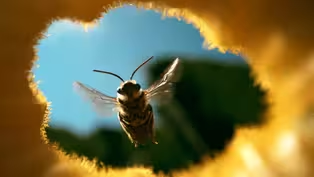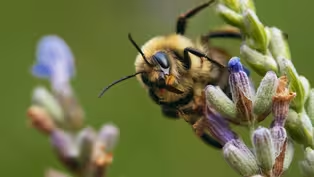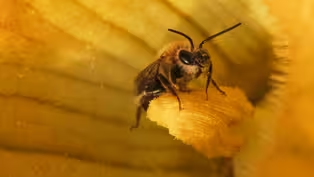
The Pollination Economy: Inside America's Bee Crisis
Clip: Season 2 Episode 4 | 12m 42sVideo has Closed Captions
Shane meets the beekeepers and scientists racing to save America's pollination workforce.
From billion-dollar almond orchards to parasite-fighting labs, Shane dives into the hidden costs of industrial pollination. Commercial beekeeper John Miller and scientist Dr. Sammy Ramsey reveal how honey bees became essential to our food system — and how diseases, parasites, and stress are pushing them to the brink. Can we save the bees before the next pollinator pandemic hits?
Problems playing video? | Closed Captioning Feedback
Problems playing video? | Closed Captioning Feedback

The Pollination Economy: Inside America's Bee Crisis
Clip: Season 2 Episode 4 | 12m 42sVideo has Closed Captions
From billion-dollar almond orchards to parasite-fighting labs, Shane dives into the hidden costs of industrial pollination. Commercial beekeeper John Miller and scientist Dr. Sammy Ramsey reveal how honey bees became essential to our food system — and how diseases, parasites, and stress are pushing them to the brink. Can we save the bees before the next pollinator pandemic hits?
Problems playing video? | Closed Captioning Feedback
How to Watch Human Footprint
Human Footprint is available to stream on pbs.org and the free PBS App, available on iPhone, Apple TV, Android TV, Android smartphones, Amazon Fire TV, Amazon Fire Tablet, Roku, Samsung Smart TV, and Vizio.
Buy Now

Surprising Moments from Human Footprint
Do you think you know what it means to be human? In Human Footprint, Biologist Shane Campbell-Staton asks us all to think again. As he discovers, the story of our impact on the world around us is more complicated — and much more surprising — than you might realize.Providing Support for PBS.org
Learn Moreabout PBS online sponsorship(soft music) (John) The conversation I’ve had more than once with an almond grower is I’m his best friend till the bloom is done and the day he releases me, it’s like, "John, get your stinging, filthy insects off my ranch."
(laughing) (water flowing) (hip-hop music) (Shane) John Miller grows some gorgeous gourds in his North Dakota garden.
(garden shears snip) But this isn’t another squash bee story.
(bees buzzing) John is a 4th-generation commercial beekeeper, which means it’s time to get my bee suit back on.
(record scratch) ♪ Miller Honey Farms, now owned by John Miller’s son, runs about 16,000 honey bee colonies from its home base in Gackle, North Dakota.
(bees buzzing) So, there’s always work to be done.
Oh, that’s way heavier than I thought it was gonna be.
(John) Honey is heavy.
It’s about 12 pounds a gallon.
(Shane) Wow.
The upper boxes are where the bees store honey.
But work your way down, and you might find the queen.
Oh yeah.
Look at her.
(John) Here she is navigating on the frame like, "Oh my gosh, there’s way too much light here."
(Shane) That’s incredible.
(bees buzzing) With 20,000 species to choose from, you might wonder why Apis mellifera, the European honey bee, is the favorite of beekeepers the world over.
(John) This guy right here is the global champion of honey production and pollination -because she’s manageable.
-Mm.
(John) You know, she’ll make this deal, like, "Okay, I’ll live in this box.
You can put me on the semi and haul me to California, and two hours later, I’ll be dialed in and know what to do."
(Shane) Okay.
And it turns out, the guy who first figured out that last part was John Miller’s great-grandfather, Nephi.
The O.G.
Miller was keeping about 300 hives in Utah when, in December 1907, he visited Southern California.
(mellow music) (John) The epiphany for him was, "I see these bees working these orange trees -in the middle of winter."
-Mm.
(John) "I wonder if I could get my bees down here?"
(Shane) Nephi realized that if his bees summered in Utah and wintered in California, he could get two honey crops a year.
But that was easier said than done.
(John) There was no way to do it.
The roads were dirt.
He went to Union Pacific Railroad Company and he said, "Have you ever thought about moving bees on a rail car?"
(Shane) And what was their response?
(John) They threw him out of the building.
(Shane) I imagine so.
It’s not surprising.
It’s like, "You wanna do what with what now?"
-Yeah.
-But eventually, he convinced them to let him try, and it actually worked.
By 1926, Miller, his sons, and associates produced the world’s first million-pound honey crop.
♪ Today, John Miller is still in the family business.
And they’re still moving bees around the country.
(John) Well, I start the year on January 15th.
(Shane) Okay.
(John) We are in the process of moving our colonies from North Dakota to California for the almond bloom.
(Shane) Almond trees cover more than 1.5 million acres of California.
That’s more than the entire state of Delaware.
(John) So, it attracts virtually every movable commercial beehive in America.
(Shane) Wow.
(John) Whether you’re a beekeeper in Massachusetts pollinating cranberries, or you’re a Florida beekeeper, -you go.
-Okay.
(John) So, it’s like this biggest paid pollination event on Earth.
(energetic music) (Shane) Three quarters of the world’s almonds, plus most of the country’s managed honey bees, equals pandemonium.
♪ (John) The flowers are in bloom and it smells so good and the bees tumble out of the entrances.
-Oh, wow.
-It’s unlike anything.
♪ (bees buzzing) ♪ (birds chirping) (bees buzzing) ♪ (Shane) Then, after just a few weeks, the show is over.
(bee buzzing) (John) We’re usually released March 10th from the almonds, we’ll move to the orange groves.
(Shane) This next leg of the tour might take the bees elsewhere in California or north to Washington.
But by mid-June, all of the Millers’ bees come back to North Dakota.
(John) There’s, like, 40 semis in 40 days.
(Shane) With no more crops to pollinate, the bees turn to storing energy.
(John) The Northern Plains are kind of this sweet spot in North America for light, mild-flavored honey.
(Shane) But getting honey from the hive to the shelf is a journey in itself.
From the bee yards, workers bring the upper boxes of each hive to the honey house.
(mellow music) They remove the frames, and a machine slices the waxy caps off the honey cells.
A giant centrifuge spins the frames to extract the honey from the honeycomb.
And another machine removes any beeswax that’s still in the mix.
♪ Finally, the pure honey is pumped into barrels to ship to a packing company.
(whooshing) When the honey harvest is finished, it’s time for the next big move.
(John) September 25th to October 10th, the bees move into the indoor storage building.
(Shane) That’s the off season?
(John) That’s the off season.
(Shane) John’s bees used to spend the winter in potato cellars in Idaho.
But these days, they stay here.
(light clicks) It’s empty now, but in a couple of months, this warehouse will house half a billion bees.
(mysterious music) (John) The whole idea is dark, and quiet, and cold.
The colony can actually enter a deeply restful state.
(soft music) (Shane) A little R&R so the bees are ready for next year’s almond bloom, because the pollination they do is just as important as the honey they make.
Which of those branches is a larger portion of the business?
That’s a really good question because over time it’s changed dramatically.
Okay.
In Nephi’s world, it was honey and nothing else.
(John) As the almond industry emerged in 1970, -that equation changed.
-Mm.
(John) Our business model is probably 70% in pollination services, maybe 65%, and 35% in honey production income.
(Shane) What does our food system look like without bees?
Walmart would have a lot of corn and a lot of rice, and I would be the greeter.
Okay.
Okay, okay.
Many of the crops we love most depend on pollination, and a lot of that work is done by commercial honey bees.
They play such a crucial role in our food system that it’s more than just beekeepers invested in their well-being.
Hey, Sammy, it’s Shane.
How’s it going?
It’s going pretty well.
How are you?
(Shane) Dr. Sammy Ramsey has one heck of a voice.
♪ I’m shedding my skin ’cause for 17 years you’re the only one ♪ (Shane) In another life, he might have even brought bugs to Broadway.
(Dr. Ramsey) ♪ There’s plenty of cicadas in the trees ♪ (bright music) (Shane) But he became an entomologist instead.
In his lab at the University of Colorado, Sammy studies parasites and diseases that affect honey bees.
♪ (Dr. Ramsey) So, I want you to take a moment and imagine a tick-like creature.
It’s about the size of a sesame seed.
Already uncomfortable, go on.
(Dr. Ramsey) Now this creature is able to climb onto the bodies of honey bees, but instead of just sucking out a little bit of their blood like a tick would, they’re releasing these digestive enzymes into the body of the bee and liquefying part of the bee’s liver and then sucking that out of the bee.
So, probably the evilest sesame seed you can imagine.
(soft music) (Shane) The sci-fi horror that Sammy just described is Varroa destructor.
It’s a parasitic mite from Asia that was accidentally introduced to Florida in 1987.
♪ Here in the U.S., Varroa spread fast, and it wasn’t long before John Miller found them in his hives.
(bees buzzing) (John) All of a sudden it was like the sky was falling.
And the losses were staggering.
(bees buzzing) (Dr. Ramsey) We have documented cases of annual losses in honey bees going from 1% to 2% all the way up to 60% to 64%.
Like, that much of the honey bee population being wiped out yearly.
(Shane) Researchers struggled to find methods of controlling Varroa.
It’s tough to kill a little bug without killing the bigger bug it lives on.
(Dr. Ramsey) We found some chemicals that work.
The problem was we usually found them one at a time, and when you only have one chemical that you’re able to utilize, what usually results is resistance.
(Shane) The mites evolved, and the control measures stopped working.
(Dr. Ramsey) We’ve had this happen at least four times with Varroa mites, and a lot of bees die as a result of it.
-(bees buzzing) -(bee smoker puffing) (Shane) European honey bees don’t have natural defenses against Varroa.
♪ Given time, they might evolve resistance to the mites.
But we can’t afford to give them that time.
(Dr. Ramsey) Our honey bees have become indispensable in terms of food security.
About $18 billion per year of the United States economy is the result of what honey bees are bringing to the table.
♪ So, we don’t have the luxury of saying, "Well, I guess we can let this disease run its course and see how many bees are left over."
(Shane) So, we’re stuck in a vicious cycle of treatment and resistance.
♪ Nothing illustrates this Catch-22 like the four-billion-dollar U.S. almond industry.
(John) The almond tree is central to the survival of North American beekeeping right now.
(Shane) Okay.
But trucking 1.5 million honey bee colonies into California each year isn’t necessarily what’s best for the bees.
(Dr. Ramsey) And if a few of those bees are sick, a lot of other bees are gonna take that back home.
We’ve had enough "super spreader" events now where we understand how this works.
(Shane) And Varroa isn’t the only danger.
Honey bees are plagued by pathogens like bacteria, fungi, and viruses.
In a phenomenon called colony collapse disorder, worker bees just leave their hives and never come back.
(bee buzzing) No one knows the exact cause, but it’s probably a combination of disease, pesticides, and stress.
(bees buzzing) In early 2025, beekeepers reported catastrophic overwinter colony losses, which some experts think could be the worst in U.S. history.
(bees buzzing) And there are other threats looming.
(Dr. Ramsey) There’s another mite called the Tropilaelaps mite or the Tropi mite; its populations grow even faster than Varroa mites.
And it’s moving around the world.
(Shane) John Miller is worried that his industry is still so focused on Varroa that they can’t see the next pollinator pandemic just over the horizon.
This one is five times worse than Varroa.
And, like, we’re asleep at the wheel again.
-Yeah.
-It amazes me.
(Shane) But John’s not giving up on bees.
(bees buzzing) (John) In this 50-year walk, I think the more I know about bees, the less I know about bees?
♪ It’s not easy, but it is the best job ever.
♪
Video has Closed Captions
Preview: S2 Ep4 | 30s | Shane investigates the future of bees, from honey bees to wild native species, in a changing world. (30s)
Rusty-Patched Rescue: Saving America's Wild Bees
Video has Closed Captions
Clip: S2 Ep4 | 4m 11s | Clay Bolt and Shane trace the decline of wild bees — and fight to bring them back. (4m 11s)
The Secret Life of Squash Bees
Video has Closed Captions
Clip: S2 Ep4 | 9m 58s | Margarita Lopez-Uribe reveals how squash bees evolved to thrive on our modern farms. (9m 58s)
Providing Support for PBS.org
Learn Moreabout PBS online sponsorship
- Science and Nature

Explore scientific discoveries on television's most acclaimed science documentary series.

- Science and Nature

Capturing the splendor of the natural world, from the African plains to the Antarctic ice.












Support for PBS provided by:


